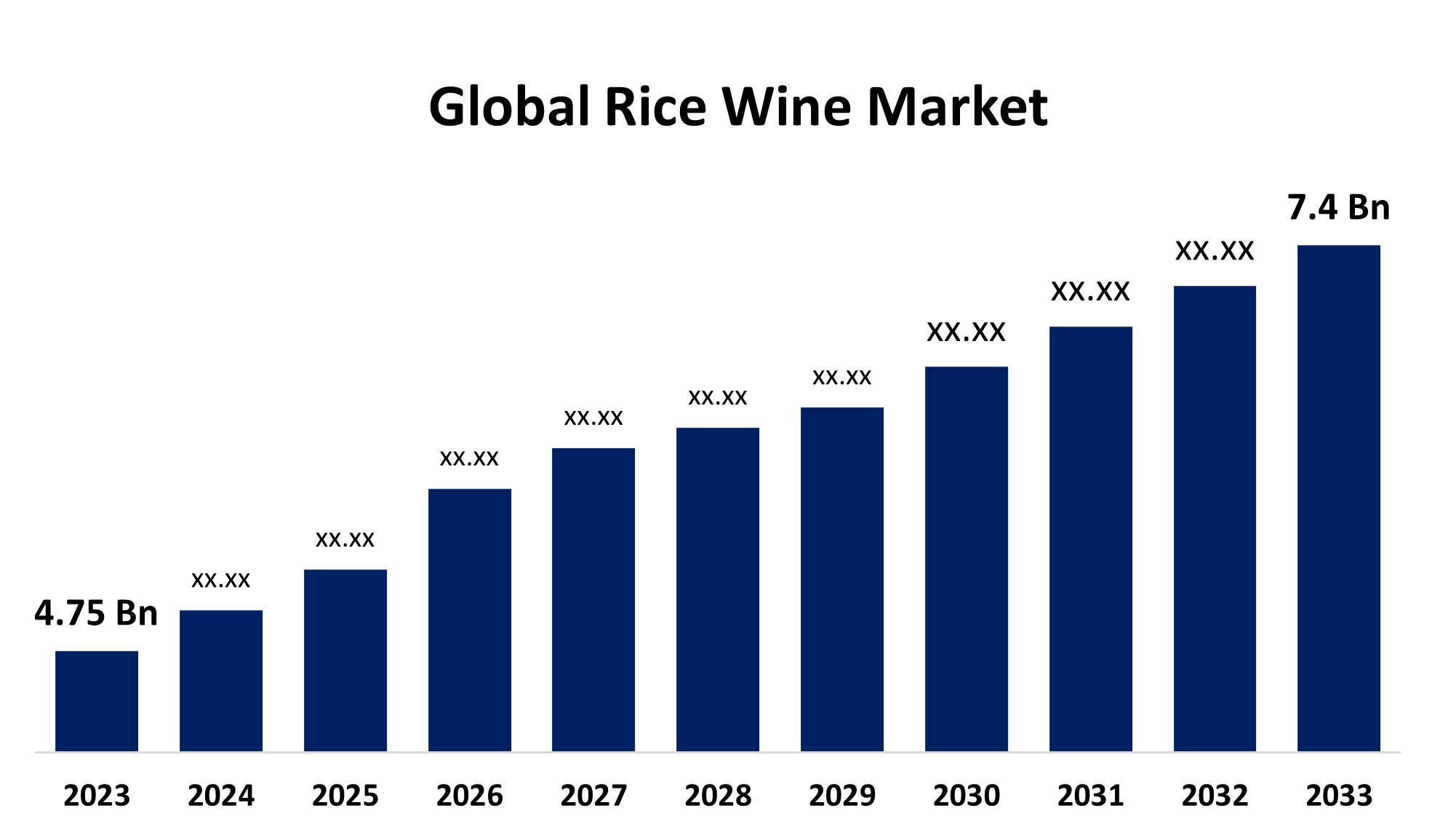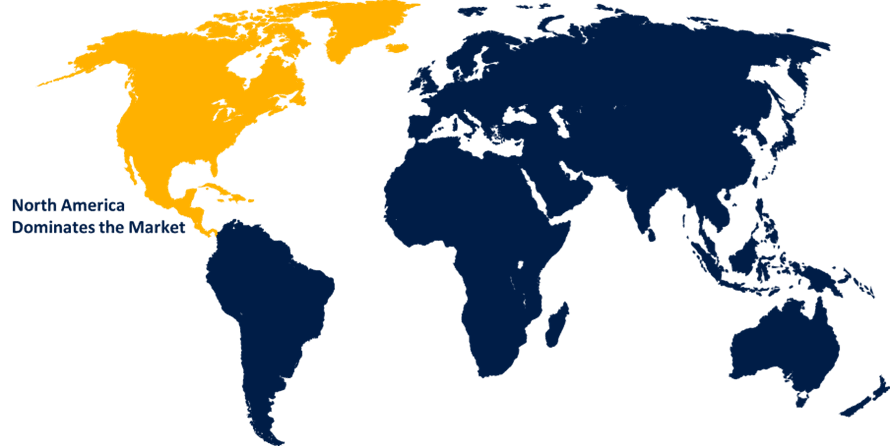Global Rice Wine Market Size, Share, and COVID-19 Impact Analysis, By Product (Sake Wine and Huangjiu Wine), By Distribution Channel (Offline and Online), and By Region (North America, Europe, Asia Pacific, Latin America, Middle East, and Africa), Analysis and Forecast 2023 - 2033
Industry: Food & BeveragesGlobal Rice Wine Market Insights Forecasts to 2033
- The Global Rice Wine Market Size was Valued at USD 4.75 Billion in 2023
- The Market Size is Expected to Grow at a CAGR of around 4.53% from 2023 to 2033
- The Worldwide Rice wine Market Size is Expected to Reach USD 7.4 Billion by 2033
- Asia Pacific is Expected to Grow the fastest during the forecast period.

Get more details on this report -
The Global Rice Wine Market Size is anticipated to exceed USD 7.4 Billion by 2033, Growing at a CAGR of 4.53% from 2023 to 2033.
Market Overview
The industry and business associated with rice wine manufacturing, distribution, and consumption are all included in the rice wine market. Traditional rice wines (such as sake and huangjiu), contemporary inventions, organic choices, and artisanal goods are all included in this market. Additionally, drinking habits have been significantly influenced by the increasing popularity of Asian food worldwide, particularly with the advent of rice wines. Rice wine and other beverages that go well with Asian food have become more and more well-liked globally as more people look for real Asian dining experiences. Not only is this trend evident in Western nations, but it is also becoming more pronounced in other Asian nations like India. A major contributor to this development has been the rise in tourism, wine tastings, and cross-cultural interactions. China, Japan, and South Korea are setting the standard for rice wines. Chinese rice wine, Korean makgeolli, and Japanese sake are among the beverages that are becoming more and more well-liked by customers around the world. These countries have a long history of creating rice wine.
Report Coverage
This research report categorizes the global rice wine market based on various segments and regions forecasts revenue growth and analyzes trends in each submarket. The report analyses the key growth drivers, opportunities, and challenges influencing the global rice wine market. Recent market developments and competitive strategies such as expansion, product launch, and development, partnership, merger, and acquisition have been included to draw the competitive landscape in the market. The report strategically identifies and profiles the key market players and analyses their core competencies in each sub-segment of the global rice wine market.
Global Rice Wine Market Report Coverage
| Report Coverage | Details |
|---|---|
| Base Year: | 2023 |
| Market Size in 2023: | USD 4.75 Billion |
| Forecast Period: | 2023 – 2033 |
| Forecast Period CAGR 2023 – 2033 : | 4.53% |
| 023 – 2033 Value Projection: | USD 7.4 Billion |
| Historical Data for: | 2019-2022 |
| No. of Pages: | 256 |
| Tables, Charts & Figures: | 93 |
| Segments covered: | By Product, By Distribution Channel and By Regional Analysis |
| Companies covered:: | Asahi Shuzo Co., Ltd., Dewazakura Sake Brewery Co., Ltd, China Shaoxing Yellow Rice Wine Group Co., Ltd., Hiro Sake LLC., Kokuryu, Kooksoondang Brewery Co. Ltd, Kuaijishan Shaoxing Wine Co., Ltd., Ozeki Sake (U.S.A.), Inc., Takara Holdings Inc, Yaegaki Corporation of USA, and Other Key Vendors. |
| Pitfalls & Challenges: | COVID-19 Impact, Challenges, Future, Growth, & Analysis |
Get more details on this report -
Driving Factors
The demand for rice wine is rising due to a growing interest in eating out and other social activities associated with changing lifestyles. Furthermore, the expansion of the tourist sector is another important factor propelling the growth of the rice wine market. When visiting Asian nations, travelers frequently buy rice wine, which is a favorite beverage among them. Consequently, as more people travel to Asia, there will be a greater need for rice wine. Additionally, the industry is expanding due to the growing demand for rice wine in Western nations. Growing disposable wealth and shifting lifestyles are driving the rice wine market. The demand for luxury rice wine, including imported types, is being driven by emerging market consumers' increased spending on non-essential goods like food and drinks. In addition, 3.3 liters of wine are used per person worldwide (260 million liters and 7.9 billion persons). This high level of wine consumption suggests that there is a strong global demand for different kinds of wine. The worldwide rice wine industry stands to gain from consumers' growing interest in a variety of alcoholic beverages. The growing desire for creative and health-conscious beverage options is another factor driving the growing interest in ethnic and traditional drinks like rice wine.
Restraints & Challenges
The market for rice wine has been severely impacted by other alcoholic beverages, especially wine and beer. Rice wine has been overshadowed by wine, particularly fruity types, which have drawn younger consumers with their sophisticated appearance and variety of flavors. Beer has become a popular alternative to rice wine due to its accessibility, affordability, and wide range of flavors.
Market Segmentation
The global rice wine market share is classified into product and distribution channel.
- The sake wine segment held the largest share in 2023 and is expected to grow at a significant CAGR during the forecast period.
Based on the product, the global rice wine market is categorized as sake wine and huangjiu wine. Among these, the sake wine sake wine segment held the largest share in 2023 and is expected to grow at a significant CAGR during the forecast period. Sake wine dominates the rice wine market primarily because to its global reputation, cultural relevance, and consistent export growth. Sake, the hallmark product of Japan's long history of brewing, has made a strong name for itself in both home and foreign markets. In 2021, sake exports reached a new high of 40.2 billion yen (USD 294 million), the 12th straight year of development, according to the Japan Sake and Shochu Makers Association.
- The online segment held the largest share in 2023 and is expected to grow at a significant CAGR during the forecast period.
Based on the distribution channel, the global rice wine market is categorized as online and offline. Among these, the online segment held the largest share in 2023 and is expected to grow at a significant CAGR during the forecast period. Rice wine's online distribution channel is expanding quickly due to a number of important variables, most notably the growth of e-commerce and shifting consumer preferences. A greater range of rice wines, like as sake, makgeolli, and huangjiu, are readily available to consumers who use digital devices and shop online.
Regional Segment Analysis of the Global Rice Wine Market
- North America (U.S., Canada, Mexico)
- Europe (Germany, France, U.K., Italy, Spain, Rest of Europe)
- Asia Pacific (China, Japan, India, Rest of APAC)
- South America (Brazil and the Rest of South America)
- The Middle East and Africa (UAE, South Africa, Rest of MEA)
North America is projected to hold the largest share of the global rice wine market over the forecast period.

Get more details on this report -
North America is projected to hold the largest share of the global rice wine market over the forecast period. The demand for rice wine has been significantly fueled by the region's diverse population, especially the Asian American community. With its unique flavors and fragrances, rice wine has become an essential component of culinary experiences as Asian cuisines gain popularity. Additionally, the industry is growing as a result of the growing usage of rice wine in cocktails and other drinks. Rice wine, which is frequently used as a beverage or as a cooking component, is in higher demand as Asian cuisine gains popularity in the United States. Furthermore, customers' growing health concern has raised demand for rice wine, which is seen as a healthier substitute for other alcoholic beverages.
Asia Pacific is expected to grow at the fastest CAGR growth of the global rice wine market during the forecast period. The culinary customs and deep cultural significance of rice wine in nations like Thailand, Korea, Japan, and China. Demand has also been boosted by these nations' expanding middle classes, who have more disposable means and a taste for high-end foods and drinks. For producers of rice wine, the South East Asian region offers an even more alluring prospect. With their thriving culinary scenes and expanding middle classes, the Philippines, Vietnam, and Thailand are seeing a boom in demand for rice wines with distinctive flavor profiles, such as lambanog and ruou gao. The need for genuine experiences and a growing interest in regional flavors are the main drivers of this trend.
Competitive Analysis:
The report offers the appropriate analysis of the key organizations/companies involved within the global rice wine market along with a comparative evaluation primarily based on their product offering, business overviews, geographic presence, enterprise strategies, segment market share, and SWOT analysis. The report also provides an elaborative analysis focusing on the current news and developments of the companies, which includes product development, innovations, joint ventures, partnerships, mergers & acquisitions, strategic alliances, and others. This allows for the evaluation of the overall competition within the market.
List of Key Companies
- Asahi Shuzo Co., Ltd.
- Dewazakura Sake Brewery Co., Ltd
- China Shaoxing Yellow Rice Wine Group Co., Ltd.
- Hiro Sake LLC.
- Kokuryu
- Kooksoondang Brewery Co. Ltd
- Kuaijishan Shaoxing Wine Co., Ltd.
- Ozeki Sake (U.S.A.), Inc.
- Takara Holdings Inc
- Yaegaki Corporation of USA
- Others
Key Target Audience
- Market Players
- Investors
- End-users
- Government Authorities
- Consulting And Research Firm
- Venture capitalists
- Value-Added Resellers (VARs)
Recent Developments
- In October 2024, Asahi Shuzo Co., Ltd. intended to increase the consumption of its well-known Dassai sake worldwide by opening its first overseas brewery in upstate New York. Offering sake with a lower alcohol content than standard kinds, the new Dassai Blue Sake Brewery aimed to appeal to US consumers, especially wine and champagne aficionados, by emphasizing a premium "junmai daiginjo."
Market Segment
This study forecasts revenue at global, regional, and country levels from 2020 to 2033. Spherical Insights has segmented the global rice wine market based on the below-mentioned segments:
Global Rice Wine Market, By Product
- Sake Wine
- Huangjiu Wine
Global Rice Wine Market, By Distribution Channel
- Offline
- Online
Global Rice Wine Market, By Regional
- North America
- US
- Canada
- Mexico
- Europe
- Germany
- UK
- France
- Italy
- Spain
- Russia
- Rest of Europe
- Asia Pacific
- China
- Japan
- India
- South Korea
- Australia
- Rest of Asia Pacific
- South America
- Brazil
- Argentina
- Rest of South America
- Middle East & Africa
- UAE
- Saudi Arabia
- Qatar
- South Africa
- Rest of the Middle East & Africa
Frequently Asked Questions (FAQ)
-
1. What is the CAGR of the global rice wine market over the forecast period?The global rice wine market size is expected to grow from USD 4.75 billion in 2023 to USD 7.4 billion by 2033, at a CAGR of 4.53% during the forecast period 2023-2033.
-
2. Which region is expected to hold the highest share of the global rice wine market?North America is projected to hold the largest share of the global rice wine market over the forecast period.
-
3. Who are the top key players in the global rice wine market?Asahi Shuzo Co., Ltd., Dewazakura Sake Brewery Co., Ltd., China Shaoxing Yellow Rice Wine Group Co., Ltd., Hiro Sake LLC., Kokuryu, Kooksoondang Brewery Co. Ltd, Kuaijishan Shaoxing Wine Co., Ltd., Ozeki Sake (U.S.A.), Inc., Takara Holdings Inc, Yaegaki Corporation of USA, and others.
Need help to buy this report?